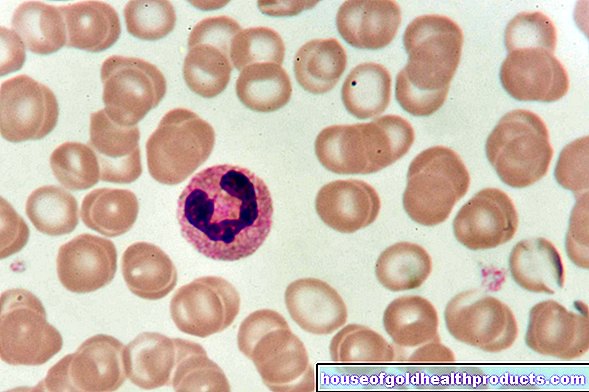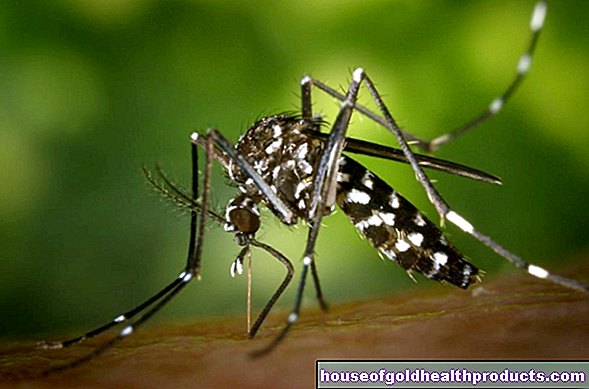Granulomatosis with polyangiitis (Wegener's disease)
and Sabine Schrör, medical journalistSophie Matzik is a freelance writer for the medical team.
More about the expertsSabine Schrör is a freelance writer for the medical team. She studied business administration and public relations in Cologne. As a freelance editor, she has been at home in a wide variety of industries for more than 15 years. Health is one of her favorite subjects.
More about the experts All content is checked by medical journalists.Granulomatosis with polyangiitis (formerly: Wegener's disease) is a chronic, inflammatory disease of the blood vessels with small, nodular thickenings of the skin (granulomas). If left untreated, it spreads throughout the body and can be fatal. The symptoms can be alleviated, but the rare disease is not curable. Read everything you need to know about granulomatosis with polyangiitis (Wegener's disease) here.
ICD codes for this disease: ICD codes are internationally recognized codes for medical diagnoses. They can be found, for example, in doctor's letters or on certificates of incapacity for work. M31

Granulomatosis with polyangiitis (Wegener's disease): definition
Granulomatosis with polyangiitis (formerly: Wegener's disease) is a rare inflammation of the blood vessels (vasculitis), accompanied by the formation of small tissue nodules in the affected areas. This leads to circulatory disorders in the affected organs and an inadequate supply of oxygen and nutrients to the tissue.
The term "granulomatosis" refers to the tissue nodules (= granulomas) formed. "Polyangiitis" means inflammation of many vessels.
Granulomatosis with polyangiitis is a systemic disease. This means that, in principle, several organ systems can be affected. As a rule, Wegener's disease initially extends to the upper respiratory tract and, in later stages, to internal organs. In addition, granulomatosis with angiitis can affect the ears and eyes.
It becomes dangerous as soon as the lungs or kidneys are affected. In extreme cases, acute pulmonary bleeding or acute kidney failure occurs. Both complications can be fatal.
New name
Granulomatosis with polyangiitis was carried under the name of Wegener's disease (also Wegener's granulomatosis or Wegener's granulomatosis) until 2011. The name change recommended by American and European rheumatism associations is based on the controversial role of the former namesake Friedrich Wegener during the Nazi era.
frequency
In Germany, an average of 0.9 out of 100,000 residents develop granulomatosis with polyangiitis every year. Men are affected slightly more often than women. In principle, Wegener's disease can occur at any age. However, children rarely get sick from it. Most diseases occur around the age of 40.
Granulomatosis with polyangiitis: symptoms & course
Granulomatosis with polyangiitis can affect different organ systems. Which organs are affected and how much varies from patient to patient.
In addition, the symptoms of Wegener's disease develop as the disease progresses: In the initial stage, the symptoms mainly appear in the ear, nose and throat area. If left untreated, the granulomatosis later spreads to other, sometimes vital organs.
Symptoms in the early stages
At the beginning of the disease, the nasal mucous membranes are usually affected. In particular, the associated symptoms include:
- (Bloody) runny nose with a constantly runny or chronically blocked nose
- Nosebleeds
- brownish crusts on the nose
- Saddle nose: The constant inflammatory processes can change the nasal septum in such a way that a saddle-shaped, sunken nose is created.
Starting from the nose, granulomatosis with polyangiitis (Wegener's disease) can spread further into the paranasal sinuses and cause inflammation there (sinusitis, sinusitis). Pain in the jaw or forehead area that is difficult to localize may indicate this.
If the disease spreads further, a middle ear infection (otitis) can develop. This manifests itself primarily as severe earache, sometimes associated with dizziness. In extreme cases, granulomatosis with polyangiitis can even lead to numbness.
General complaints such as fever, night sweats, weight loss, general feeling of illness and weakness as well as increased tiredness also occur in the early stages of the disease.
Symptoms in the further course
As the disease progresses, the symptoms of inflammation continue to spread throughout the body. Mainly affected are:
- Throat: Hoarseness, difficulty swallowing or a dry cough set in when the granulomatosis with polyangiitis spreads to the throat and pharynx.
- Muscles and joints: The joints, especially the legs and arms, have painful swellings and tenderness. Muscle pain can also occur.
- Lungs, pleura, heart: In around 60 percent of Wegener's disease patients, the disease affects the lungs after a while. A frequent consequence is pneumonia with a bloody cough. The inflammation can spread from the lungs to the pleura (pleurisy, pleurisy). An inflammation of the pericardium (pericarditis) with subsequent pericardial effusion (pericardial tamponade) is also possible.
- Eyes: Around 50 percent of those affected suffer from granulomatosis with polyangiitis (Wegener's disease) from eye pain, burning eyes, eye inflammation or visual disturbances (visual loss). From the outside, you can sometimes see bleeding in the eye, as well as red patches of skin and small skin nodules around the eye.
- Kidneys: In around 50 percent of those affected by granulomatosis, the kidney vessels become inflamed (glomerulonephritis). Classic signs of this are visible traces of blood in the urine (macrohematuria). In addition, there is high blood pressure (hypertension) and the so-called nephrotic syndrome with water retention in the tissue (edema).
- Skin: Blisters and punctiform or extensive discoloration may appear on the skin. These arise from the death (necrosis) of tissue. If larger blood vessels under the skin are also involved, doctors speak of gangrene. Such skin symptoms occur in around 20 percent of granulomatosis cases.
- Nervous system: In about 10 percent of cases, granulomatosis extends to the central or peripheral nervous system. Possible consequences are numbness and abnormal sensations in fingers and toes (polyneuropathy). Unsteady gait, headaches and weakness in the limb muscles are less common. Meningitis can also develop.
Granulomatosis with polyangiitis: therapy
As with many other diseases, the same applies: the earlier granulomatosis with polyangiitis is detected, the higher the chance of successful treatment.
Acute therapy
The stage of the disease has a significant influence on how the therapy in acute cases looks like in Wegener's disease - the decisive factor is whether vital organs are affected and / or there is an acute danger to life or not:
No danger to life or involvement of vital organs
In such cases, Wegener's disease consists of the combined administration of drugs that suppress the immune system (immunosuppressive combination therapy): The patients receive prednisolone (a cortisone) and either methotrexate (MTX) or mycophenolate mofetil.
Danger to life or involvement of vital organs
If organs such as the lungs or kidneys are already affected by the disease, aggressive immunosuppressive combination therapy is indicated. High-dose prednisolone is combined either with cyclophosphamide or with rituximab.
In severe cases, plasmapheresis can also be performed if necessary:
In this elaborate procedure, blood is drawn out of the patient's body via an infusion tube and into the plasma treatment device. This device uses a centrifuge to separate the liquid part of the blood (blood plasma or plasma for short) from the solid parts (red blood cells, etc.) and replaces it with a substitute liquid - a mixture of electrolytes and hydrogen carbonate. The blood is then returned to the patient's body.
The purpose of it all: With plasmapheresis, the antibodies in the plasma are also removed, which are involved in the inflammatory processes in granulomatosis with polyangiitis (Wegener's disease).
Maintenance therapy (maintenance of remission)
If an improvement of the symptoms (remission) was achieved with the acute treatment, a maintenance therapy of at least 24 months follows. The aim is to maintain the freedom from symptoms achieved through acute treatment over the long term. The immunosuppressant azathioprine (alternatively rituximab, MTX or mycophenolate mofetil) and the glucocorticoid prednisolone are preferably used. Co-trimoxazole can also be given.
Repeated treatment
It is important that all treatment measures only alleviate the symptoms. Wegener's disease is not curable. In more than half of all patients, the symptoms return within two years after successful therapy. These can then be treated in the same way as with the first therapy. In the course of the disease, relapses with severe symptoms can occur again and again.
Granulomatosis with polyangiitis: prognosis
With timely treatment, the spread of inflammation in granulomatosis with polyangiitis can be counteracted. In 75 percent of those affected, the symptoms then completely regress. However, the disease often breaks out again over time, which then each time requires immunosuppressive combination therapy. With optimal treatment, however, 85 percent of all patients with Wegener's disease are still alive after five years.
In contrast, the prognosis without treatment looks very bad. The further the inflammation spreads in the body, the greater the potential damage. These include, for example, deafness or pulmonary fibrosis. If the kidneys are affected, death from kidney failure usually occurs within six months. In general, the following applies: If Wegener's disease is untreated, the mean survival time is less than a year.
Granulomatosis with polyangiitis: causes
The exact cause of the granulomatosis with polyangiitis (Wegener's disease) is still unknown. Scientists suspect that the disease is due to a malfunction of the immune system (autoimmune disease): Due to a malfunction, the immune system forms antibodies against the body's own cells, in this case blood cells.
An infection of the nasal mucosa with bacteria such as Staphylococcus aureus discussed. Parts of the bacteria can activate certain immune cells, which then trigger an excessive immune reaction against the body's own cells.
Granulomatosis with polyangiitis (Wegener's disease): diagnosis
If there is a suspicion of Wegener's disease, this should be clarified as quickly and carefully as possible. This enables rapid treatment if granulomatosis with polyangiitis is actually present.
The first point of contact for suspected granulomatosis is the family doctor or an internist.
anamnese
First, the doctor will record your medical history (anamnesis). Here you have the opportunity to describe your symptoms in detail. You should calmly go into anything you noticed. Even small things that may seem unimportant or irrelevant to you can help the doctor to find out the cause of the symptoms. The doctor can also ask questions such as
- When did you first notice the changes (e.g. tissue nodules)?
- Have you noticed any other symptoms?
- Have you noticed blood in your urine?
- Do you have pain when coughing or breathing hard, for example while exercising?
Blood test
As a rule, a blood count is first made to clarify the suspected diagnosis.
The detection of c-ANCA is an almost certain indication of Wegener's granulomatosis. The abbreviation stands for cytoplasmic anti-neutrophil cytoplasmic antibodies. These are certain autoantibodies against certain blood cells. C-ANCA can be detected in the vast majority of all patients with Wegener's disease. However, these autoantibodies are also found in some other diseases (such as tuberculosis) in the blood of those affected. Therefore, an increased c-ANCA value alone is not sufficient to make a diagnosis of granulomatosis with polyangiitis.
An increased sedimentation rate (ESR, blood sedimentation) is also an indication of Wegener's disease if it is accompanied by an increased number of white blood cells (leukocytosis). Taken alone, however, none of these values is evidence of Wegener's disease.
Urinalysis
Doctors can use urine tests to find out whether the kidneys are affected. If the kidneys are weak (renal insufficiency), an increased creatinine level can be measured in the urine. In glomerulonephritis, blood is found in the urine (hematuria): In the first stages of the disease, there are tiny traces of blood that can only be seen under the microscope (microhematuria). In later stages, the blood can also be seen with the naked eye (macrohematuria).
Tissue samples
Tissue samples (biopsies) from the nasal mucosa, for example, are very informative. If the doctor suspects that internal organs (such as lungs, kidneys) are already affected, tissue samples can also be taken from them. If corresponding inflammatory changes are found in the samples, this confirms the diagnosis of granulomatosis with polyangiitis (Wegener's disease).
Tags: diet prevention healthy feet





























